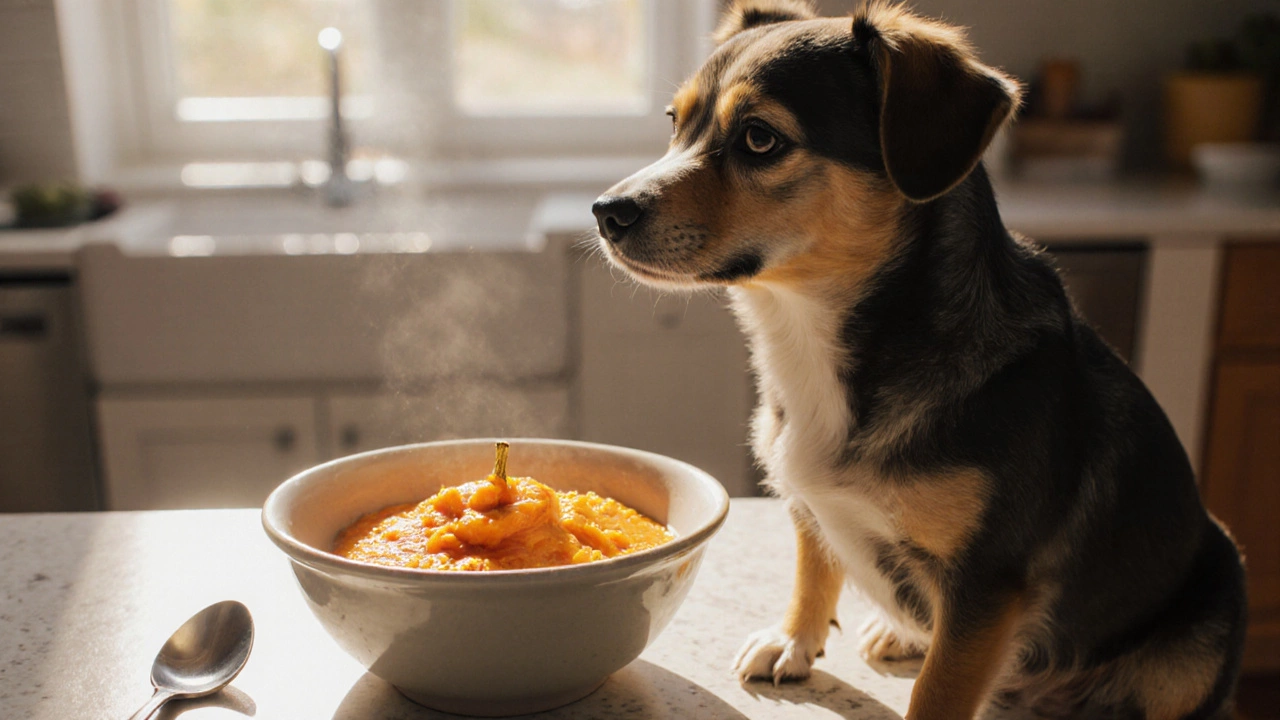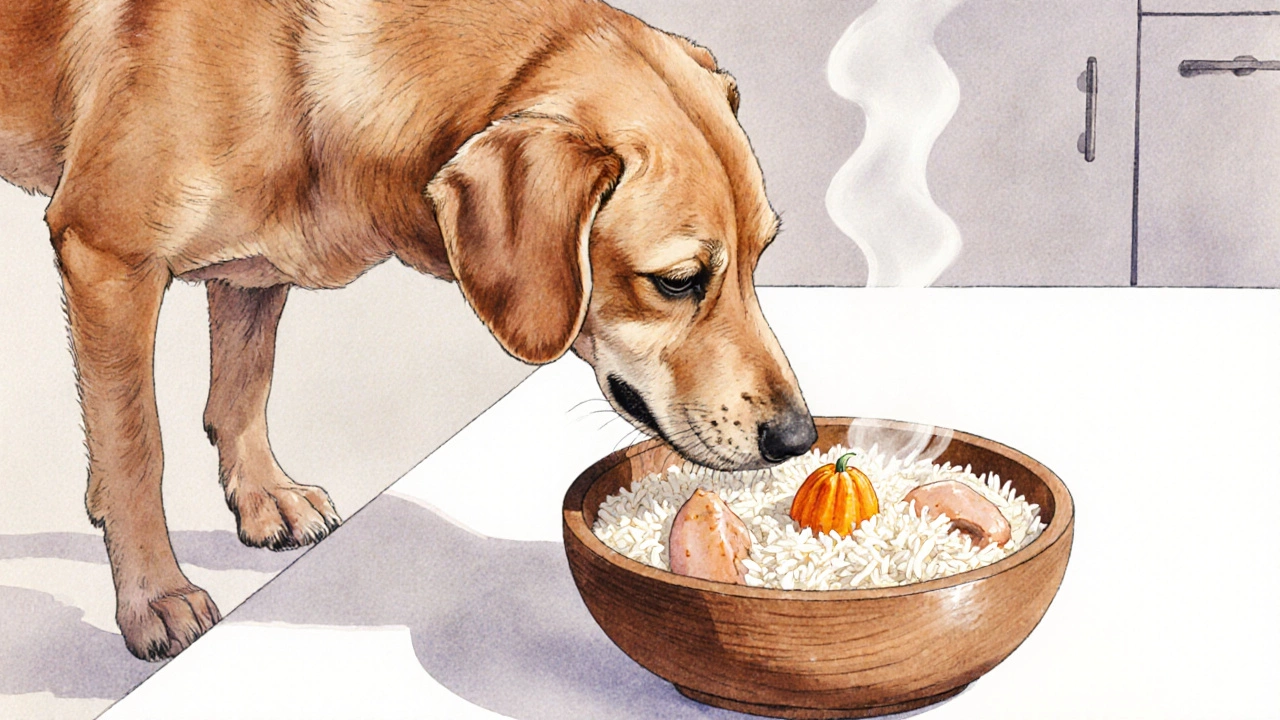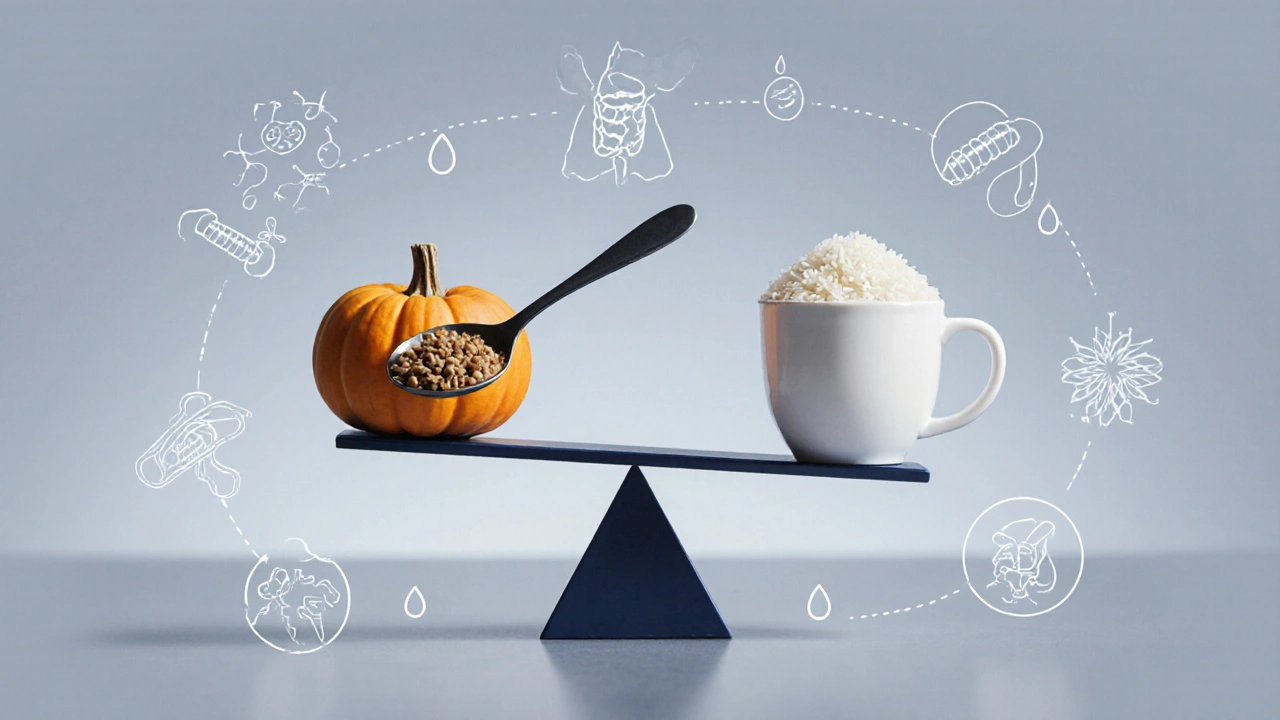
Dog Diarrhea Home Remedy Calculator
Input Your Dog's Information
How This Works
Based on veterinary guidelines: Pumpkin adds soluble fiber to firm stools while rice provides gentle carbohydrates for gut rest.
Important: Only use 100% pure pumpkin (no pie filling), plain white rice, and boiled chicken.
Use for no more than 2 days with rice and 5 days with pumpkin. Stop if symptoms worsen.
When your dog has diarrhea, you don’t need to rush to the vet right away-unless it’s bloody, lasts more than 48 hours, or your dog is lethargic. For mild cases, many pet owners turn to simple, bland foods to settle the stomach. Two of the most common suggestions? Pumpkin and rice. But which one actually works better? And more importantly, how do you use them safely?
Pumpkin: The Fiber Fix
Pumpkin isn’t just for pies. Plain, canned pumpkin (not pie filling) is packed with soluble fiber, which helps absorb excess water in the intestines and firm up loose stools. It’s not a magic cure, but it’s one of the most reliable home remedies vets recommend for mild diarrhea in dogs.
A 2023 study from the University of California’s Veterinary Nutrition Lab found that dogs fed 1-4 tablespoons of plain pumpkin per day (depending on size) showed improved stool consistency within 12-24 hours. Smaller dogs (under 20 lbs) need just 1 tablespoon, while larger breeds (over 50 lbs) can handle up to 4 tablespoons.
Why does it work? Soluble fiber in pumpkin turns into a gel in the gut, slowing digestion and helping the colon reabsorb water. It also feeds good bacteria in the gut, which helps restore balance after a digestive upset. Unlike some fiber sources, pumpkin is gentle on the stomach and rarely causes bloating.
Important: Only use 100% pure pumpkin. No spices, no sugar, no additives. If you’re unsure, check the label-ingredients should say only “pumpkin.”
Rice: The Carb Comfort
White rice has been a go-to for dog owners for decades. It’s easy to digest, low in fat, and bland-exactly what a dog’s upset stomach needs. When mixed with boiled chicken or lean ground beef, it forms the classic bland diet vets suggest for short-term digestive recovery.
Rice works differently than pumpkin. Instead of adding fiber, it provides easily absorbed carbohydrates that give the gut a break. The starch in white rice coats the intestinal lining, reducing irritation. It doesn’t fix the root cause of diarrhea, but it helps your dog feel better while their system resets.
One downside? Rice lacks fiber. If your dog’s diarrhea is caused by too much loose stool and not enough bulk, rice alone won’t help much. In fact, feeding only rice for more than a day or two can lead to constipation, especially in active or older dogs.
Always cook rice plain-no butter, salt, oil, or seasoning. Use long-grain white rice. Brown rice has more fiber but is harder to digest when the gut is inflamed, so skip it during acute diarrhea.
Head-to-Head: Pumpkin vs. Rice
Here’s how they stack up when your dog has diarrhea:
| Feature | Pumpkin | Rice |
|---|---|---|
| Primary action | Adds soluble fiber to firm stools | Provides easy carbs to rest the gut |
| Best for | Loose, watery stools | Stomach irritation, post-illness recovery |
| Speed of results | 12-24 hours | 6-12 hours (feels better faster) |
| Duration safe to use | Up to 5 days | Max 2 days |
| Risk of constipation | Low | Medium |
| Added benefits | Supports gut bacteria, low calorie | Quick energy, easy to digest |
So which is better? It depends on what’s going on inside your dog’s gut.
If your dog’s poop is watery and frequent, pumpkin is the better first choice. It adds the missing bulk. If your dog is vomiting, refusing food, or just looks miserable after eating something weird, rice gives them quick relief and something safe to eat.

How to Use Them Together
You don’t have to pick one. Many vets recommend combining both for a balanced approach.
Here’s a simple plan:
- Fast your dog for 12-24 hours (water only) to let the gut rest.
- After fasting, offer small meals of boiled chicken (skinless, no seasoning) and plain white rice in a 1:2 ratio (1 part chicken, 2 parts rice).
- Add 1-2 tablespoons of plain pumpkin per meal, depending on your dog’s size.
- Feed 3-4 small meals a day for the next 2-3 days.
- Slowly mix in their regular food over the next 2 days, watching for signs of relapse.
This combo gives you the quick energy from rice and the stool-firming fiber from pumpkin. It’s gentle, effective, and commonly used in vet clinics across New Zealand and the U.S.
What Not to Do
There are a lot of myths out there. Avoid these common mistakes:
- Don’t use pumpkin pie filling-it has sugar, cinnamon, and nutmeg, which can be toxic to dogs.
- Don’t feed raw pumpkin. It’s hard to digest and may cause more upset.
- Don’t use brown rice during acute diarrhea-it’s too fibrous and can irritate further.
- Don’t add butter, oil, or seasoning to rice or chicken. Even a little salt can be harmful.
- Don’t keep your dog on bland food longer than 3-5 days. They need balanced nutrition.

When to Call the Vet
Home remedies work for mild cases. But diarrhea can be a sign of something serious:
- Diarrhea lasts more than 48 hours
- There’s blood or mucus in the stool
- Your dog is vomiting, feverish, or refusing water
- Your dog is very young, old, or has a chronic condition like diabetes or kidney disease
- You suspect they ate something toxic-chocolate, grapes, xylitol, or human meds
In these cases, don’t wait. Diarrhea can lead to dehydration quickly, especially in small dogs. A vet can run tests for parasites, infections, or food allergies that home remedies won’t fix.
Preventing Future Episodes
Once your dog’s back to normal, think about what caused it. Common triggers include:
- Scavenging-eating trash or food off the floor
- Changing food too fast
- Stress from travel, new pets, or loud noises
- Parasites like giardia or worms
- Food intolerances (common in dogs with sensitive stomachs)
Keep a probiotic supplement on hand for dogs with recurring issues. Look for ones with live cultures like Lactobacillus acidophilus or Bifidobacterium. You can also slowly introduce pumpkin into their regular diet a few times a week-not just during flare-ups-to keep their digestion steady.
Final Verdict
Pumpkin and rice aren’t rivals-they’re teammates. Pumpkin fixes the stool. Rice soothes the gut. Used together, they’re one of the safest, most effective ways to handle mild diarrhea in dogs.
But remember: they’re temporary fixes, not long-term solutions. If your dog keeps having digestive issues, talk to your vet. There might be an underlying food sensitivity or health condition that needs proper diagnosis.
For most dogs, a spoonful of pumpkin and a cup of plain rice will get them back on their feet in a day or two. And that’s worth knowing.
Can I feed my dog pumpkin every day?
Yes, but in moderation. A tablespoon or two of plain pumpkin a few times a week can help maintain regular digestion. It’s low-calorie and rich in vitamins, making it a healthy snack. But don’t overdo it-too much fiber can cause gas or loose stools.
Is white rice or brown rice better for dogs with diarrhea?
White rice is better during active diarrhea. It’s easier to digest and less likely to irritate the gut. Brown rice has more fiber and nutrients, but that fiber can make loose stools worse. Save brown rice for when your dog’s system has recovered.
How much pumpkin should I give my dog?
For small dogs (under 20 lbs): 1 tablespoon per meal. Medium dogs (20-50 lbs): 2 tablespoons. Large dogs (50+ lbs): up to 4 tablespoons. Always mix it into their food, and don’t exceed 5 days without checking with your vet.
Can I use sweet potato instead of pumpkin?
Sweet potato is another good option-it’s high in fiber and vitamins. But it’s also higher in sugar and calories than pumpkin. Use it sparingly during diarrhea, and only in small amounts. Pumpkin is still the safer first choice.
Why does my dog keep getting diarrhea?
Recurring diarrhea often points to food sensitivities, parasites, stress, or a chronic condition like IBD (inflammatory bowel disease). If it happens more than twice a month, ask your vet for a food trial, fecal test, or blood work. Don’t just keep feeding pumpkin and rice-you’re treating symptoms, not the cause.





